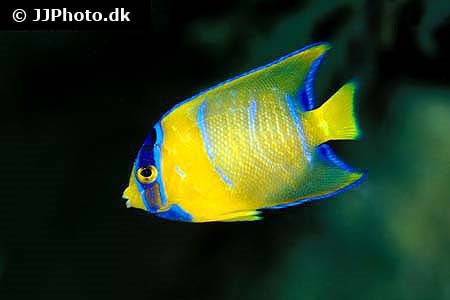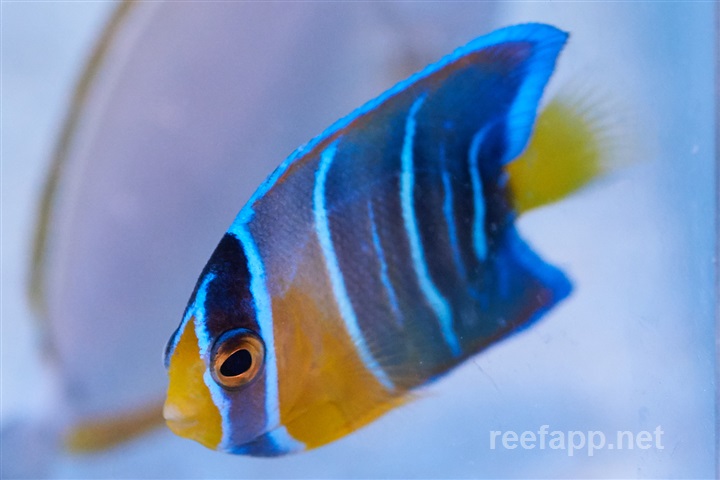Holacanthus bermudensis



| Latin name | Holacanthus bermudensis |
|---|---|
| Local name | Blue Angelfish |
| Family | Pomacanthidae - Holacanthus |
| Origin | The Mexican Golf, West Atlantic |
| Max length | 45 cm (17.7") |
| Minimum volume |
900 l (237 gal) |
|---|---|
| Hardiness |
Average |
| Suitable for aquarium |
Suitable with care |
| Reef safe |
Not reef safe |
| Aggressiveness | Aggressive towards other species |
| Recommended |
Larger crustaceans (Shrimp, crabs...) Macroalgea (Eg. seaweed / nori) Microalgea (Eg. spirulina) Small crustaceans (Krill, mysis, artemia...) Sponges |
|---|---|
| Maybee |
Large polyp stone coral (LPS) Other invertebrates Parasites Soft coral Zooplankton (Cyclops, pods...) |
This species sometimes nibbles at clams including Tridacna species.
This species can be extremely aggressive towards other fish.
Be careful when keeping these fish together with peaceful or docile species. Regular feeding, plenty of hiding places and a lot of space can alleviate aggressive behavior to some degree.
This species must be fed with an appropriately varied diet.
This fish requires feeding several times a day, especially when newly added.
When the fish can find its natural food in the aquarium it requires less frequent feeding.
These fish should be kept in a well run aquarium where they can "graze" algae from rocks and stones.
If there are insufficient algae on the rocks, it is important to feed more frequently and supplement with algae rich food e.g. Spirulina.
This species needs good hiding places, for example, between live rocks.
This species revels in swimming and requires an aquarium with ample space.
Even though these fish enjoy a diverse type of frozen foods, it is imperative that its primary food, is algae based, thus ensuring that the fish`s immune system remains healthy.
This can, for example, be plant based fish flakes, Nori seaweed or similar.
It can be a challenge to keep corals together with Angelfish, since the latter eat most soft corals and LPS. Especially Zoathus are swiftly eaten by the larger species.
It is however possible to build up a mixed coral aquarium with Angelfish. If some of the following corals are choosen there is a good chance the Angelfish will leave them alone; Hammer corals, Bubble corals, Star polyps, Disc anemones and others.
Most of the SPS corals can be kept with Angelfish.
It is possible to keep various different sizes of Angelfish in the same aquarium, but it means that one must choose species with care and that the conditions in the tank are optimum.
Here are some suggestions to increase the chances of success:
Choice of species
It is important not to choose species that are too similar, the greater the variance, the larger the chance of success. It is also advantageous to choose fish of different sizes. Two young Angelfish of the same same size and pattern for example are a bad idea. One should of course avoid the most aggressive species.
Order of introduction
It is a good idea to make a wishlist and choosing the order so, that the least aggressive are introduced first. When adding similar sized Ange fish it works best if they are introduced simultaneously.
Space
There should be enough space in the aquarium, but it is difficult to give specific advice. Of course there are exceptions to the table below as to just how big a tank should be in order to stand a good chance of success. Space itself is not enough, there should also be sufficient hiding places so the fish do not have to fight over these.
100 gal (400 liters): Several small Angelfish (<15cm) can live together.
240 gal (900 liters): Several medium Angelfish (< 20cm) can live together.
400 gal (1500 liters): Several large Angelfish (<25cm) can live together.
Food and water quality
It is always helpful to give the fish a varied diet, so they can withstand the occasional stress situation when for example new fish are introduced. Water quality must also be very high, so that the fish do not get stressed for that reason either.
These fish resemble Holacanthus ciliaris greatly, both when young and adults.
When young, this species typically has three curved lines on its side and two horizontal stripes, whilst H. ciliaris has four curved lines and one horizontal.
When fully grown this species has a blue tail with a yellow edge, whilst H. ciliaris's tail is completely yellow.
There are occasionally hybrids between the two, which makes it even more difficult to determine the correct species.
Angelfish of the Holacanthus family are generally large, attractive and very colourful.
Holacanthus are some of the hardier Angelfish, but they are still vulnerable to parasitic attack and need quality varied food with a good supply of nori and Spirulina.
One must avoid a too protein rich food as this stops them obtaining enough vitamin A
They are not reef-safe, but some of this species can, with a little care, be kept in a coral aquarium.
Holacanthus are known for their aggressiveness, so one must have a large tank to keep these fish. Especially the smaller ones are very quarrelsome.
Generally speaking it cannot be recommended keeping these Angelfish together with other Holacanthus or docile fish in general. Even with others of the Angelfish genus, there is a big risk in keeping them with Holacanthus, but it can be done.
Angelfish (Pomacanthidae) are known as some of the most colourful and impressive fish on the reef.
Many species are not reef safe, as they especially target the soft corals and LPS. But by choosing your corals carefully, or by getting specific species of Angelfish, they can be kept in coral aquariums.
There are Angelfish suitable for most aquarium sizes, from Dwarf Angelfish which are well suited to smaller aquaria, to the larger of the species which can be impressively displayed in a larger aquarium.
The demands of the individual species can vary widely. Some are food specialists and require therefore special food, while for others can be difficult to acclimatize, as they live in deep water in the wild. It is recommended that one has a reasonably good knowledge of the different types of food and of treatments of illnesses, if one wishes to keep the larger species.
Niels K. 2014. Private conversation - saltvandsforum.dk - (Danish)
Scott W. Michael. 2004. Angelfishes and Butterflyfishes (Reef Fishes Series Book 3) TFH Publications / Microcosm Ltd. - (English)
Bob Fenner. Marine Angelfishes, Family Pomacanthidae - Wet Web Media - (English)
Bob Fenner. The Best Angelfishes For Marine Aquarium Use - Wet Web Media - (English)
Bob Fenner. The Ultimate Angelfish Aquarium; An amazing and challenging collection of marine angelfishes - Wet Web Media - (English)
Collection of links to additional information - Wet Web Media - (English)
Reef Central. 2009. Keeping more than one emperor angelfish together - (English)

